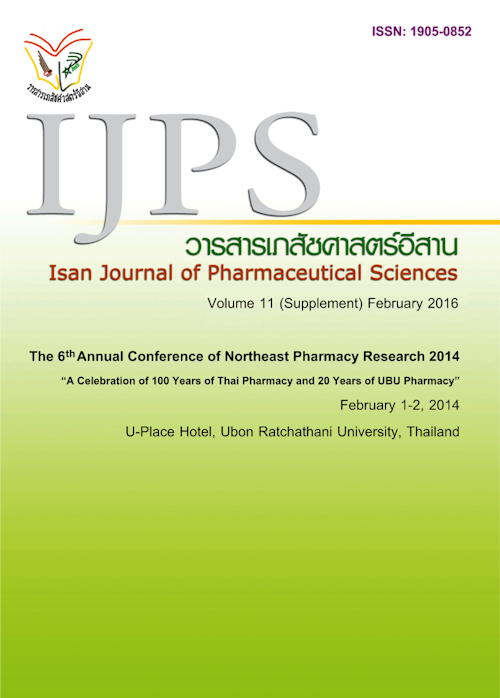Encapsulation of Polyphenolic Antioxidants from Cratoxylum formosum ssp. formosum Leaf Extract in Nanostructured Lipid Carriers for Cosmetics applications
Main Article Content
Abstract
Introduction: Cratoxylumformosum ssp. formosum (CFF) leaf extract contains high amount of polyphenolic content and has strongly antioxidant activity but its high aqueous solubility may lead to low skin permeation. Encapsulation of the CFF extract in nanostructure liquid carriers (CFF-NLC) is an interesting method to enhance the delivery of the active into deeper layer of skin. Objective is encapsulation the CFF extract in nanostructured liquid carriers (NLC) and 24-factorial central composite design was used to obtain the obtimized formulations. Materials and Method: Phenolic compounds from CFF leaves were extracted in the mixture of ethanol 78% and water. The amount of phenolic compound in the CFF was determined by using 5-O-caffeoylquinic acid as a standard biomarker. Antioxidant activity was assessed by DPPH·free radical scavenging assay. The CFF-NLC was then prepared using hot melted homogenization using a 24-factorial central composite design. The CFF-NLC was composed of Compritol®888 ATO+GMS®1:1), Lexol® GT 865, Tween®80+Lutrol® F68 (1:1) and CFF. Results: The CFF extract showed IC50 value of 26.49±1.27 µg/mL with amount of 5-O-caffeoylquinic acid at41.66±0.07 mg/g. The optimum conditions for CFF-NLC preparations wereX1 = 5.77%w/w, X2= 45%w/w, X3= 3.3%w/w, and X4= 2%w/w. The mean particle size of the optimum CFF-NLC, polydispersity index, zeta potential, and entrapment efficiency were 125.67±3.21 nm, 0.158±0.011, -11.20±0.40 mV and 57.58±3.14%, respectively. The experimental values were well correspondent to the predicted values obtained from the proposed mathematical model. Encapsulation of CFF extract into NLC gave a controlled released property and improved skin permeation. Conclusion: CFF-NLC was a promising candidate for delivery the antioxidants for further cosmetic applications.
Article Details
In the case that some parts are used by others The author must Confirm that obtaining permission to use some of the original authors. And must attach evidence That the permission has been included
References
Arion WJ, Canfield WK, Ramos FC, Schindler PW, Burger HJ, et al. 1997. Chlorogenic acid and hydroxynitrobenzalcenyde: new inhibitors of hepatic glucose 6-phosphatase. Archieves of Biochemistry and Biophysics 339: 315-322.
Bassoli BK, Cassolla p, Borba-Murad GR, Constantin J, Salgueiro-Pagadigorria CL, et al. 2008. Chlorogenic acid reduces the plasma glucose peak in the oral glucose tolerance test: Effects on hepatic glucose release and glycaemia. Cell Biochemistry and Function 26: 320-328. Clifford MN. 2000.
Chlorogenic acids and other cinnamates-nature, occurrence, dietary burden, absorption and metabolism. Journal of the Science of Food and Agriculture 80: 1033-1043.
Sripanidkulchai K., Teepsawang S., and Sripanidkulchai B. 2010. Journal of Medicinal Food. 13(5): 1097-1103.
Kukongviriyapan U, Luangaram S, Leekhaosoong K, Kukongviriyapan Preeprame S. 2007. Antioxidant and vascular protective activities of Cratoxylum formosum.Syzygium gratum and Limnophila aromatica. Biological and Pharmaceutical Bulletin 30: 611-666.
Maisuthisakul p, Pongsawatmanit R. Gordon MH. 2007. Characterization of the phytochemical and antioxidant properties of extracts from Teaw (Cratoxylum formosum Dyer). Food Chemistry 100: 1620-228.
McCarty MF. 2005. A chlorogenic acid-induced increase in GLP-1 production may mediate the impact of heavy coffee consumption on diabetes risk. Medical Hypotheses 64: 848-853.
Venugaranti VV, Perumal OP, Chapter 9. Nanosystems for Dermal and Transdermal Drug Delivery, in: Pathak Y, Thassu D. Drug Delivery Nanoparticles Formulation and Characterization. New York: Informa Healthcare USA, Inc., .55-2009:126


